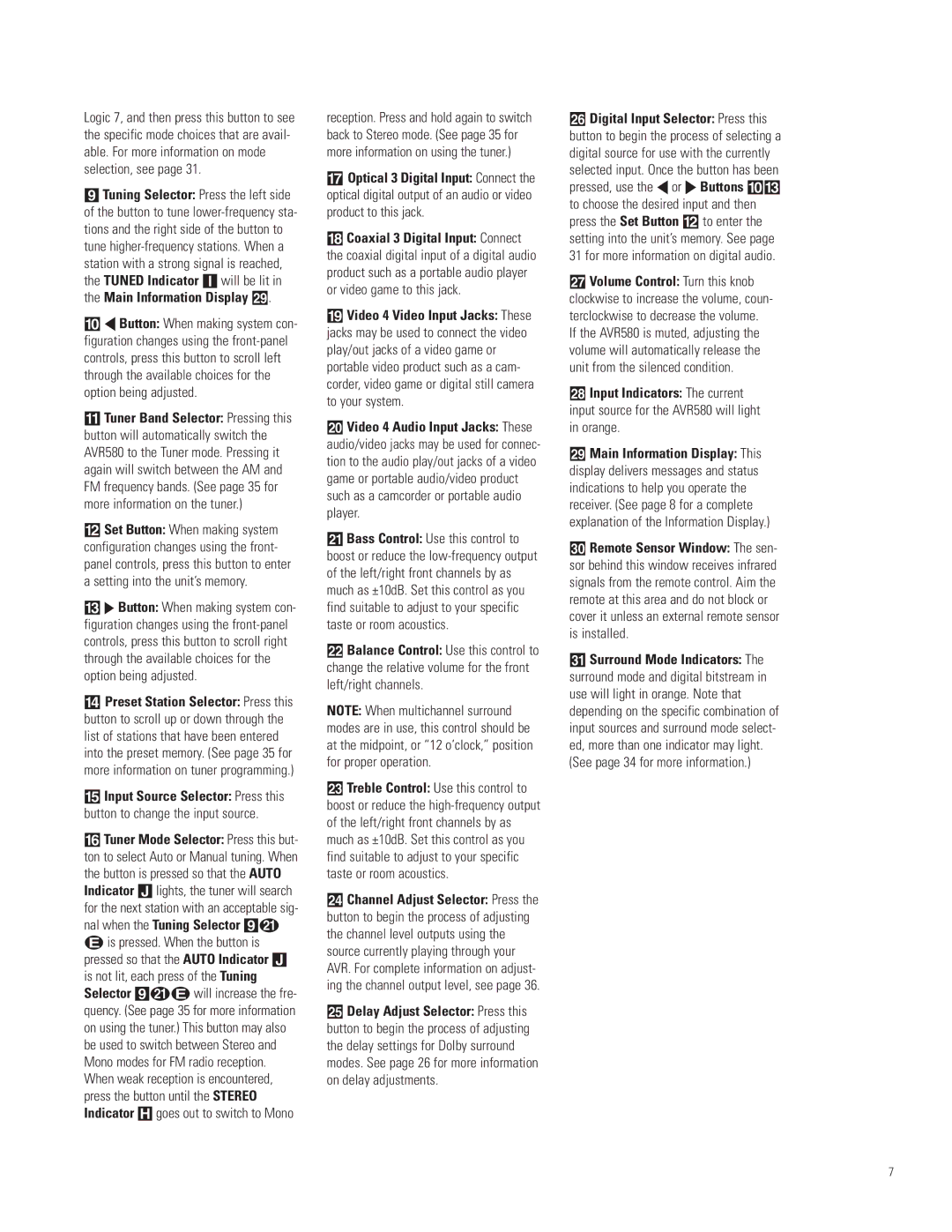Logic 7, and then press this button to see the specific mode choices that are avail- able. For more information on mode selection, see page 31.
9Tuning Selector: Press the left side of the button to tune lower-frequency sta- tions and the right side of the button to tune higher-frequency stations. When a station with a strong signal is reached, the TUNED Indicator I will be lit in the Main Information Display ˜.
)‹ Button: When making system con- figuration changes using the front-panel controls, press this button to scroll left through the available choices for the option being adjusted.
!Tuner Band Selector: Pressing this button will automatically switch the AVR580 to the Tuner mode. Pressing it again will switch between the AM and FM frequency bands. (See page 35 for more information on the tuner.)
@Set Button: When making system configuration changes using the front- panel controls, press this button to enter a setting into the unit’s memory.
#› Button: When making system con- figuration changes using the front-panel controls, press this button to scroll right through the available choices for the option being adjusted.
$Preset Station Selector: Press this button to scroll up or down through the list of stations that have been entered into the preset memory. (See page 35 for more information on tuner programming.)
%Input Source Selector: Press this button to change the input source.
^Tuner Mode Selector: Press this but- ton to select Auto or Manual tuning. When the button is pressed so that the AUTO Indicator J lights, the tuner will search for the next station with an acceptable sig- nal when the Tuning Selector 9u é is pressed. When the button is pressed so that the AUTO Indicator J is not lit, each press of the Tuning Selector 9ué will increase the fre- quency. (See page 35 for more information on using the tuner.) This button may also be used to switch between Stereo and Mono modes for FM radio reception. When weak reception is encountered, press the button until the STEREO Indicator H goes out to switch to Mono
reception. Press and hold again to switch back to Stereo mode. (See page 35 for more information on using the tuner.)
&Optical 3 Digital Input: Connect the optical digital output of an audio or video product to this jack.
*Coaxial 3 Digital Input: Connect the coaxial digital input of a digital audio product such as a portable audio player or video game to this jack.
(Video 4 Video Input Jacks: These jacks may be used to connect the video play/out jacks of a video game or portable video product such as a cam- corder, video game or digital still camera to your system.
ÓVideo 4 Audio Input Jacks: These audio/video jacks may be used for connec- tion to the audio play/out jacks of a video game or portable audio/video product such as a camcorder or portable audio player.
ÔBass Control: Use this control to boost or reduce the low-frequency output of the left/right front channels by as much as ±10dB. Set this control as you find suitable to adjust to your specific taste or room acoustics.
Balance Control: Use this control to change the relative volume for the front left/right channels.
NOTE: When multichannel surround modes are in use, this control should be at the midpoint, or “12 o’clock,” position for proper operation.
ÒTreble Control: Use this control to boost or reduce the high-frequency output of the left/right front channels by as much as ±10dB. Set this control as you find suitable to adjust to your specific taste or room acoustics.
ÚChannel Adjust Selector: Press the button to begin the process of adjusting the channel level outputs using the source currently playing through your AVR. For complete information on adjust- ing the channel output level, see page 36.
ÛDelay Adjust Selector: Press this button to begin the process of adjusting the delay settings for Dolby surround modes. See page 26 for more information on delay adjustments.
ÙDigital Input Selector: Press this button to begin the process of selecting a digital source for use with the currently selected input. Once the button has been pressed, use the ‹ or › Buttons )# to choose the desired input and then press the Set Button @ to enter the setting into the unit’s memory. See page 31 for more information on digital audio.
ıVolume Control: Turn this knob clockwise to increase the volume, coun- terclockwise to decrease the volume.
If the AVR580 is muted, adjusting the volume will automatically release the unit from the silenced condition.
ˆInput Indicators: The current input source for the AVR580 will light in orange.
˜Main Information Display: This display delivers messages and status indications to help you operate the receiver. (See page 8 for a complete explanation of the Information Display.)
¯Remote Sensor Window: The sen- sor behind this window receives infrared signals from the remote control. Aim the remote at this area and do not block or cover it unless an external remote sensor is installed.
˘Surround Mode Indicators: The surround mode and digital bitstream in use will light in orange. Note that depending on the specific combination of input sources and surround mode select- ed, more than one indicator may light. (See page 34 for more information.)
